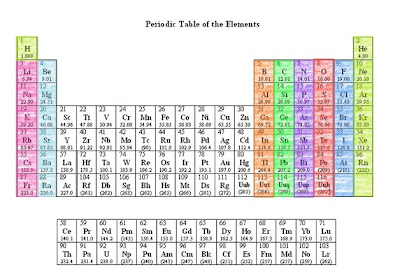| Figure I. Pauling Electronegativity Values |
American chemist Linus Pauling (1901 - 1994) devised a scale of relative electronegativity values by assigning fluorine, the most electronegative element, a value of 4. 0. The figure above displays the electronegativity values known to date.
Chlorine (3. 0) is more electronegative than hydrogen (2. 1). In a hydrogen chrloride molecule, the chlorine atom holds the shared electrons more tightly. This results in the chlorine end of the molecule being more megative than the hydrogen end. When electrons are not equaly shared, the bond is assumed to be polar. Therefore, the bond in a hydrogen chloride molecule is described as a polar covalent bond, whereas the bond in a hydrogen molecule or a chlorine molecule is a non-polar covalent bond.
A polar covalent bond is not an ionic bond. In an ionic bond, an atom completely loses an electron. In a polar covalent bond, the atom at the positive end of the bond (hydrogen in HCl) still has some share in the bonding pair of electrons, as seen in figure II. To distinguish this arrangement from an ionic bond, the following notation is used:
 |
| Figure II. Representation of the Polar Hydrogen Chloride Molecule |
The line between the atoms represents the covalen bond, a pair of shared electrons. The δ+ and δ- (read as "delta plus" and "delta minus") signify which end is partially positive and which is patially negative, wherein the word "partially" is used to distinguish this charge from the full charge on an ion.
Using the electronegativity values for atoms in a compound, the type of bonding may be predicted. When the electronegativity difference is zero or is very small (<0. 5), the bond is non-polar covalent, with essentially equal sharing of electrons. When the electronegativity difference is large (>2. 0), complete electron transfer occurs and an ionic bond is formed, as in the case of sodium and chlorine. When the electron negativity difference is between 0. 5 and 2. 0, polar covalent bonds are formed.
PRACTICE EXERCISES
Classify the type of bond seen between each pairs of atoms as non-polar, polar, or ionic.
- Two hydrogen atoms
- Oxygen and hydrogen
- Carbon and hydrogen
- Nitrogen and three hydrogen atoms
- Sodium and chlorine
SOLUTIONS
- Two H atoms have the same electronegativity; the electronegativity difference is 0; the bond is non-polar covalent.
- The electronegativity difference of 3. 5 - 2. 1 is 1. 4; the bond is polar covalent.
- The electronegativity difference of 2. 5 - 2. 1 is 0. 4; the bond is non-polar covalent.
- The electronegativity of N is 3. 0, that of H is 2. 1, so all three N--H bonds are polar covalent.
- The electronegativity difference of 3. 0 - 0.9 is 2. 1; the bond is ionic.
Group I
Michaela Panaguiton
Nadine Leano
Ella Canuel
Jenny Gonzales
Published by Michaela Panaguiton





